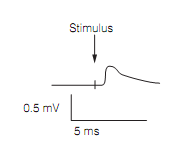Excitatory postsynaptic potentials
The Activation of ionotropic receptors which are nonselective cation conductances (that is, also those permeable to Na+ plus K+ and possibly Ca2+) depolarizes the synaptic membrane. This is for the reason that the reversal potential for the current via these receptors is close to zero. As this brings the potential membrane of the neuron closer to the threshold voltage at which the action potentials are triggered, and it increases the probability that the cell might fire. Therefore depolarizing synaptic potentials are known as excitatory postsynaptic potentials (epsps). The separate epsp has no chance of making a central neuron fire; it is far too small to have a major effect on the postsynaptic cell. Only when many epsps are produced on a neuron within tens of milliseconds of each other is there any prospect of driving the neuron across threshold. The main fast excitatory transmitters are glutamate and acetylcholine. The Glutamate transmission was first studied in the spinal cord where sensory nerve axons from muscles form the axodendritic synapses directly on the motor neurons which is as shown in figure.

Figure: Excitatory postsynaptic potentials in the spinal motor neurons in response to stimulating a single sensory axon.
There are many points to be noted about the excitatory postsynaptic potentials which are as shown below:
- It is technically tough to record separate epsps at vertebrate synapses, therefore normally the epsp resultant from the activation of many synapses is recorded at the cell body.
- They are graded and small in size, ranging from fractions of a millivolt to about 8 mV. Stimulating more axons activates more synapses that make the epsp larger.
- There is a short delay of 0.5–1 ms between stimulating the afferents and the creation of an epsp. This is termed as the synaptic delay.
- They usually last for about 10–20 ms while decaying exponentially.